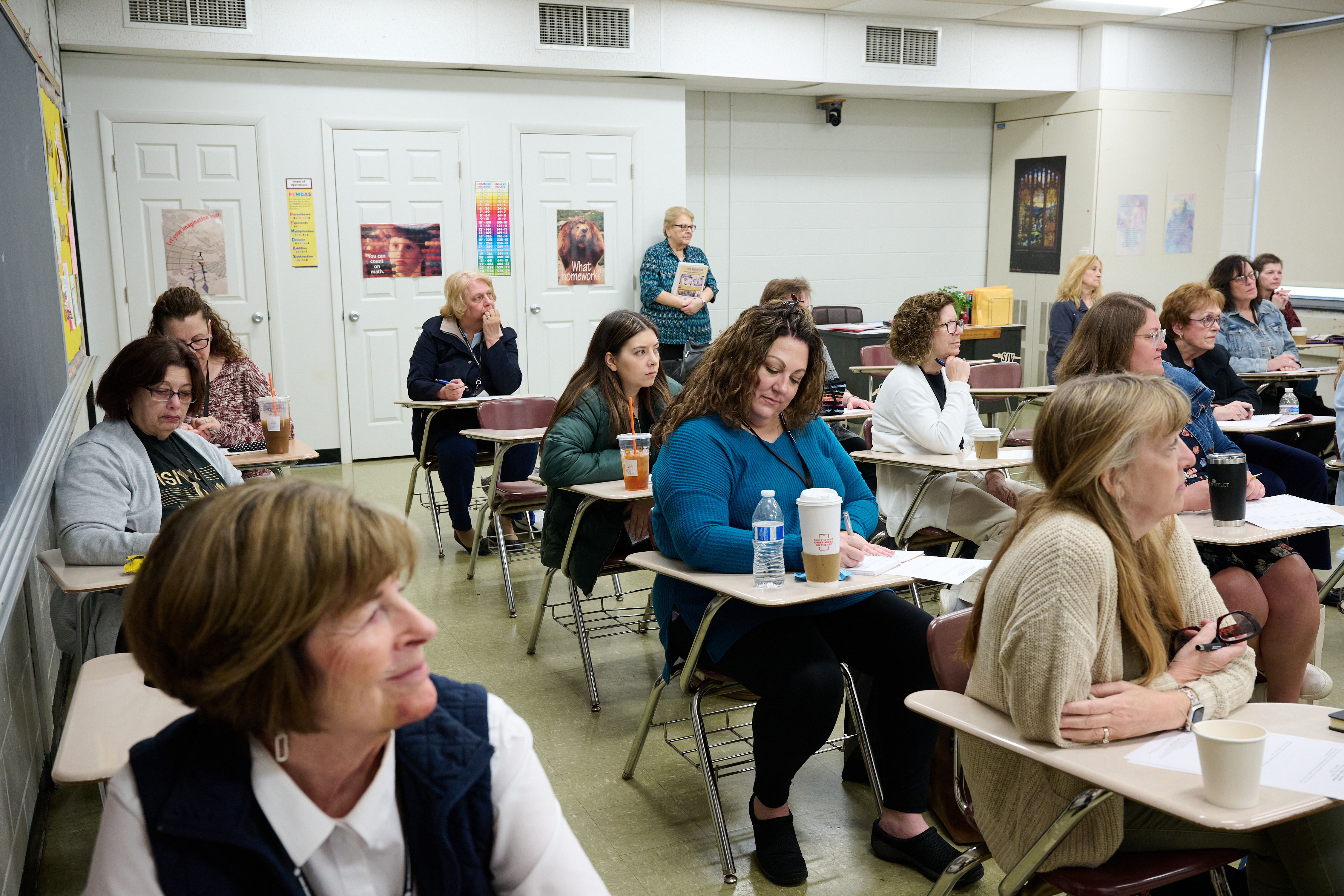Conference workshops provide many opportunities for growth
April 15, 2025 at 3:35 p.m.

 Jim Tortorici, executive director of the New Jersey Campus of the Encounter School of Ministry, leads a breakout session on the benefits of small Christian communities. More than 50 breakout sessions during the Hope in Our Hearts conference allowed participants to expand their ministry toolkits. The following is a sample of the variety of workshops offered.
Jim Tortorici, executive director of the New Jersey Campus of the Encounter School of Ministry, leads a breakout session on the benefits of small Christian communities. More than 50 breakout sessions during the Hope in Our Hearts conference allowed participants to expand their ministry toolkits. The following is a sample of the variety of workshops offered.
Best Practices for Parish Social Media Engagement
Susan Hammer, who handles communication and special projects in St. Catharine Parish, Holmdel, was impressed to learn about the “eye-opening statistics” presented on the top five social medial platforms that garner billions of users, during the workshop on social media engagement.
Presenter Rose O’Connor, diocesan digital and social media manager, covered the importance of social media in engaging parishioners, reaching them where they are and using affordable, measurable tools to promote parish activities and faith formation, namely through Facebook and Instagram. Her presentation emphasized strategic, authentic and engaging social media use to maximize the parish’s reach and impact.
Hammer said she appreciated O’Connor’s reminder that “We live in a world driven by social media, connecting people, sharing information and building real relationships.”
The Significance of Gestures and Postures in the Mass
In a workshop on gestures and postures in Mass, Father Jorge Bedoya, pastor of Jesus, the Good Shepherd Parish, Beverly, debunked common myths and corrected misconceptions about church etiquette.
Every action during the celebration of the liturgy, he said, should reflect the concept of “for Him, with Him, and in Him” – the focus must always be on God, not on oneself or potential distractions. He said preparation for Mass begins long before entering church, starting with clothing choice, getting the family ready, and even managing practical details like the car ride and traffic.
Gestures show respect: the Sign of the Cross, kneeling for prayer, bowing before the Blessed Sacrament, genuflecting and reverence toward the altar.
He stressed avoiding distractions or superficial gestures. “The posture we take is a way of telling God that we are attentive and offering all of our being, without exaggeration or neglect.”
Omitting reverence, he continued, is a lack of respect for the sacred. As an example, he shared how people may sometimes sit too casually during the liturgy, chew gum, or make the Sign of the Cross without effort. Conversely, exaggerated gestures are also disrespectful. “It’s not about us … it is about genuine reverence, always reflecting it back to Him,” he said.
“The moment of consecration is the moment to contemplate the mystery of our faith,” Father Bedoya said. “It is a moment to ... see the mystery of God.”
 Participants listen attentively to a morning breakout session, one of more than a dozen offered before the keynote address. Mike Ehrmann photos
Participants listen attentively to a morning breakout session, one of more than a dozen offered before the keynote address. Mike Ehrmann photos
Accompanying Adolescent Learners with and without Disabilities
Dr. Anne Masters, director of Pastoral Ministry with Persons with Disabilities, Archdiocese of Newark, told participants in her workshop that “the experience of disability is very broad, and presumptions we have about what is ‘normal’” put “some people at a disadvantage to participating.”
Offering a new perspective, she pointed to the importance of catechists promoting a culture of welcome and belonging to accompany all adolescent learners.
“Recalling the parable of the sower and the seed, instead of focusing on the condition of the internal soil of your soul,” Dr. Masters said, “what is the soil in your parish and catechetical group to receive the people of God? Is it rocky? Thorny? More fertile?”
As catechists, she reminded the group, “there is a learning that happens … but you are providing a witness to your faith and a guide in the faith of those you walk with … It’s less about memorizing the 10 Commandments than knowing that ‘I really want to care about the kid next to me or across the street.’”
Accompanying learners “is about nurturing relationship,” Dr. Masters said. “Disability is more than a definition … expectations, the way we lay out physical space, the process for doing things, can either increase or decrease someone’s access to participation.”
To facilitate learning, she suggested “getting to know your learners … start with strengths and interests … see the person before the disability and tap into what kids are reading and watching.”
Strength in Unity: Building Effective Ministry Teams
“No one does ministry alone!” Mary Mykityshyn told the parish ministers in her breakout session on effective ministry teams. “As the Body of Christ, by virtue of our Baptism, we are called to serve,” she said.
Mykityshyn, parish catechetical leader in St. Gabriel Parish, Marlboro, offered pointers on what to keep in mind when starting a new ministry or any type of endeavor. First, she said, ministry leaders must be “Christ-like in your treatment of members. Be kind, gentle, clear, a good communicator and inclusive.”
Mykityshyn said it’s a good idea to start small with a core, trusted group for ministry. She advised ministers to be intentional in planning, model the ideal culture, starting and finishing on time.
Understandably, people will become upset or frightened if a project they worked on does not pan out.
“So, what if it doesn’t? You tried it and you can always tweak a program and begin again,” Mykityshyn said.
“Remember, if you are at the end of the diving board, jump in. You will swim. Just try it.”
How to Connect Youth to the Saints in Modern-Day Life
 Many of the bilingual conference workshops were also offered in Spanish for a diversity of participants.
Many of the bilingual conference workshops were also offered in Spanish for a diversity of participants. Amy Raimondi, youth minister in St. Theresa Parish, Little Egg Harbor, offered insights into how to make the lives of the saints relatable to young people. She included suggestions for bringing saints into activities throughout the year.
Connecting saints to service projects, such as praying a novena to a saint during the event with a prayer pause every 10 minutes, teaches the youth that “it’s not just a task, it’s why we’re doing it, who we’re praying for,” she said.
Other ideas included discovering saints displayed around their church buildings and focusing on the parish’s namesake saint with an art or poster competition, including hosting a display at its conclusion to bring in the whole parish.
“Use Flocknote or emails to families as a reminder” of a saint’s feast day, with links to information, Raimondi said. If someone in a class has been sick, she continued, the catechist could suggest, “Today we’re going to pray for the intercession of St. Jude and for all in our families who are sick.”
Andrea Dinger, seventh-grade catechist for Nativity Parish, Fair Haven, found the workshop helpful.
“Bringing the saints into our students’ lessons and communities can refocus each of us on our journey,” she said. A key takeaway for Dinger was that “Students’ knowledge of saints can build the background for more meaningful intercessory prayers.”
Find hope, speakers urge hundreds of parish ministers at diocesan conference
Related Stories
Sunday, December 14, 2025
E-Editions
Events
 Jim Tortorici, executive director of the New Jersey Campus of the Encounter School of Ministry, leads a breakout session on the benefits of small Christian communities. More than 50 breakout sessions during the Hope in Our Hearts conference allowed participants to expand their ministry toolkits. The following is a sample of the variety of workshops offered.
Jim Tortorici, executive director of the New Jersey Campus of the Encounter School of Ministry, leads a breakout session on the benefits of small Christian communities. More than 50 breakout sessions during the Hope in Our Hearts conference allowed participants to expand their ministry toolkits. The following is a sample of the variety of workshops offered.
Best Practices for Parish Social Media Engagement
Susan Hammer, who handles communication and special projects in St. Catharine Parish, Holmdel, was impressed to learn about the “eye-opening statistics” presented on the top five social medial platforms that garner billions of users, during the workshop on social media engagement.
Presenter Rose O’Connor, diocesan digital and social media manager, covered the importance of social media in engaging parishioners, reaching them where they are and using affordable, measurable tools to promote parish activities and faith formation, namely through Facebook and Instagram. Her presentation emphasized strategic, authentic and engaging social media use to maximize the parish’s reach and impact.
Hammer said she appreciated O’Connor’s reminder that “We live in a world driven by social media, connecting people, sharing information and building real relationships.”
The Significance of Gestures and Postures in the Mass
In a workshop on gestures and postures in Mass, Father Jorge Bedoya, pastor of Jesus, the Good Shepherd Parish, Beverly, debunked common myths and corrected misconceptions about church etiquette.
Every action during the celebration of the liturgy, he said, should reflect the concept of “for Him, with Him, and in Him” – the focus must always be on God, not on oneself or potential distractions. He said preparation for Mass begins long before entering church, starting with clothing choice, getting the family ready, and even managing practical details like the car ride and traffic.
Gestures show respect: the Sign of the Cross, kneeling for prayer, bowing before the Blessed Sacrament, genuflecting and reverence toward the altar.
He stressed avoiding distractions or superficial gestures. “The posture we take is a way of telling God that we are attentive and offering all of our being, without exaggeration or neglect.”
Omitting reverence, he continued, is a lack of respect for the sacred. As an example, he shared how people may sometimes sit too casually during the liturgy, chew gum, or make the Sign of the Cross without effort. Conversely, exaggerated gestures are also disrespectful. “It’s not about us … it is about genuine reverence, always reflecting it back to Him,” he said.
“The moment of consecration is the moment to contemplate the mystery of our faith,” Father Bedoya said. “It is a moment to ... see the mystery of God.”
 Participants listen attentively to a morning breakout session, one of more than a dozen offered before the keynote address. Mike Ehrmann photos
Participants listen attentively to a morning breakout session, one of more than a dozen offered before the keynote address. Mike Ehrmann photos
Accompanying Adolescent Learners with and without Disabilities
Dr. Anne Masters, director of Pastoral Ministry with Persons with Disabilities, Archdiocese of Newark, told participants in her workshop that “the experience of disability is very broad, and presumptions we have about what is ‘normal’” put “some people at a disadvantage to participating.”
Offering a new perspective, she pointed to the importance of catechists promoting a culture of welcome and belonging to accompany all adolescent learners.
“Recalling the parable of the sower and the seed, instead of focusing on the condition of the internal soil of your soul,” Dr. Masters said, “what is the soil in your parish and catechetical group to receive the people of God? Is it rocky? Thorny? More fertile?”
As catechists, she reminded the group, “there is a learning that happens … but you are providing a witness to your faith and a guide in the faith of those you walk with … It’s less about memorizing the 10 Commandments than knowing that ‘I really want to care about the kid next to me or across the street.’”
Accompanying learners “is about nurturing relationship,” Dr. Masters said. “Disability is more than a definition … expectations, the way we lay out physical space, the process for doing things, can either increase or decrease someone’s access to participation.”
To facilitate learning, she suggested “getting to know your learners … start with strengths and interests … see the person before the disability and tap into what kids are reading and watching.”
Strength in Unity: Building Effective Ministry Teams
“No one does ministry alone!” Mary Mykityshyn told the parish ministers in her breakout session on effective ministry teams. “As the Body of Christ, by virtue of our Baptism, we are called to serve,” she said.
Mykityshyn, parish catechetical leader in St. Gabriel Parish, Marlboro, offered pointers on what to keep in mind when starting a new ministry or any type of endeavor. First, she said, ministry leaders must be “Christ-like in your treatment of members. Be kind, gentle, clear, a good communicator and inclusive.”
Mykityshyn said it’s a good idea to start small with a core, trusted group for ministry. She advised ministers to be intentional in planning, model the ideal culture, starting and finishing on time.
Understandably, people will become upset or frightened if a project they worked on does not pan out.
“So, what if it doesn’t? You tried it and you can always tweak a program and begin again,” Mykityshyn said.
“Remember, if you are at the end of the diving board, jump in. You will swim. Just try it.”
How to Connect Youth to the Saints in Modern-Day Life
 Many of the bilingual conference workshops were also offered in Spanish for a diversity of participants.
Many of the bilingual conference workshops were also offered in Spanish for a diversity of participants. Amy Raimondi, youth minister in St. Theresa Parish, Little Egg Harbor, offered insights into how to make the lives of the saints relatable to young people. She included suggestions for bringing saints into activities throughout the year.
Connecting saints to service projects, such as praying a novena to a saint during the event with a prayer pause every 10 minutes, teaches the youth that “it’s not just a task, it’s why we’re doing it, who we’re praying for,” she said.
Other ideas included discovering saints displayed around their church buildings and focusing on the parish’s namesake saint with an art or poster competition, including hosting a display at its conclusion to bring in the whole parish.
“Use Flocknote or emails to families as a reminder” of a saint’s feast day, with links to information, Raimondi said. If someone in a class has been sick, she continued, the catechist could suggest, “Today we’re going to pray for the intercession of St. Jude and for all in our families who are sick.”
Andrea Dinger, seventh-grade catechist for Nativity Parish, Fair Haven, found the workshop helpful.
“Bringing the saints into our students’ lessons and communities can refocus each of us on our journey,” she said. A key takeaway for Dinger was that “Students’ knowledge of saints can build the background for more meaningful intercessory prayers.”
Find hope, speakers urge hundreds of parish ministers at diocesan conference










